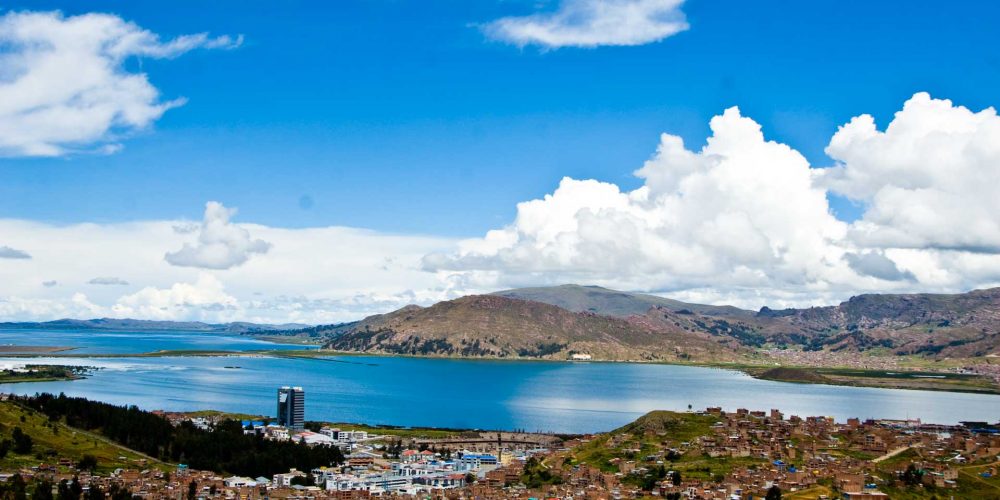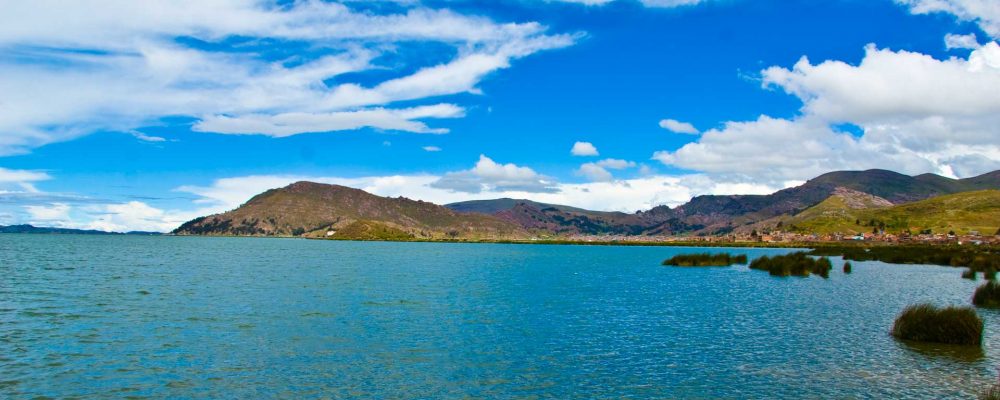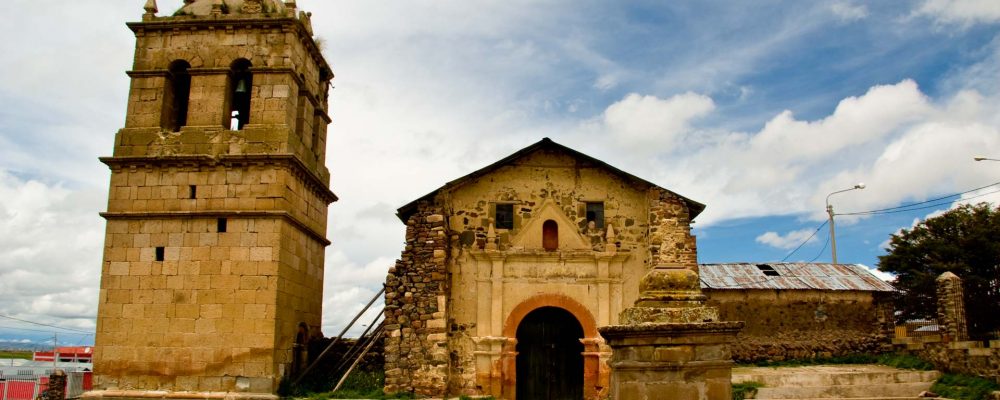Titicaca Lake
Lake Titicaca, nestled high in the Andes at an elevation of 12,507 feet (3,812 meters), holds the distinction of being the world’s highest navigable lake. Straddling the border between Peru and Bolivia, this ancient lake is steeped in cultural and historical significance. Revered by the indigenous people of the region, particularly the Uros who inhabit floating islands crafted from totora reeds, Titicaca is a living testament to the rich traditions of the Andean cultures. The deep blue waters of the lake are dotted with picturesque islands, such as Isla del Sol and Isla de la Luna, each with its own unique charm and archaeological remnants. Titicaca’s allure extends beyond its breathtaking scenery, offering a glimpse into the spiritual and cultural tapestry that has woven itself into the fabric of this high-altitude haven for centuries.

Table of Contents
Overview
Lake Titicaca is one of the most remarkable and culturally significant bodies of water in the world. Straddling the border between Peru and Bolivia in the Andes Mountains, it is the largest lake in South America by volume and the highest navigable lake on the planet, sitting at an elevation of approximately 3,812 meters (12,507 feet) above sea level. The lake has a surface area of around 8,372 square kilometers (3,232 square miles) and reaches a maximum depth of about 281 meters (922 feet).
The cultural and historical significance of Lake Titicaca is immense, as it has been a focal point for various pre-Columbian civilizations, particularly the Inca Empire. Numerous ancient ruins and archaeological sites surround the lake, including the famous floating islands of the Uros people, who have lived on man-made reed islands for centuries. These islands are constructed from the totora reed, which grows abundantly in the shallows of Lake Titicaca.
Isla del Sol (Island of the Sun) and Isla de la Luna (Island of the Moon), situated on the Bolivian side of the lake, are two islands that hold great religious and mythological significance in Inca culture. According to Inca legend, Isla del Sol is believed to be the birthplace of the Sun God, Viracocha.
Lake Titicaca is not only culturally rich but also ecologically diverse. The surrounding region is home to a variety of flora and fauna, and the lake itself supports unique species, including several types of fish found nowhere else. The lake’s crystal-clear waters and stunning mountain backdrop make it a popular destination for tourists seeking both cultural experiences and natural beauty.
In recent years, Lake Titicaca has faced environmental challenges, including pollution and threats to its delicate ecosystem. Efforts are being made by local communities, governments, and environmental organizations to address these issues and preserve the lake’s unique heritage for future generations.
Overall, Lake Titicaca stands as a symbol of the rich cultural tapestry and ecological wonders that characterize the Andean region, drawing visitors from around the world to marvel at its beauty and explore its historical significance.
History

Lake Titicaca, located in the Andes on the border between Peru and Bolivia, is the largest lake in South America by volume and one of the highest navigable lakes in the world, sitting at an elevation of over 3,800 meters (12,500 feet) above sea level. Its history is rich and intertwined with the ancient cultures that have inhabited its shores for thousands of years.
Pre-Columbian Cultures:
Lake Titicaca has been a significant cultural and religious center for various pre-Columbian cultures, most notably the Tiwanaku and later the Inca civilization. The Tiwanaku culture, which thrived from around 500 to 1000 AD, left behind impressive archaeological sites on the lake’s shores, such as the ruins of Tiwanaku near the lake’s southern edge. These ancient civilizations considered the lake sacred and believed it to be the birthplace of their ancestors.
Inca Civilization:
The Inca, who rose to power in the 15th century, also held Lake Titicaca in high regard. According to Inca mythology, the god Viracocha emerged from the waters of the lake to create the sun, moon, and stars. The Inca established several important centers around the lake, including the island of Taquile, which served as a religious and agricultural hub.
Floating Islands of the Uros:
The Uros people, an indigenous group that predates the Inca civilization, inhabit the floating islands on Lake Titicaca. These islands are constructed from totora reeds, which grow abundantly in the shallow waters of the lake. The Uros people have lived on these artificial islands for centuries, relying on fishing and traditional crafts for their livelihood.
Colonial Era:
With the arrival of the Spanish conquistadors in the 16th century, the indigenous cultures around Lake Titicaca faced significant challenges. The Spanish sought to impose their cultural and religious practices, leading to the decline of many traditional customs. The city of Puno, located on the shores of Lake Titicaca, became an important colonial outpost.
Modern Times:
In the contemporary era, Lake Titicaca continues to be a vital resource for the people living in the region. Fishing and agriculture are central to the local economy. The lake also attracts tourists who come to explore its unique islands, ancient ruins, and vibrant indigenous cultures.
Challenges and Conservation:
Despite its historical and cultural significance, Lake Titicaca faces modern challenges such as pollution, overfishing, and invasive species. Efforts are underway by local communities and international organizations to address these issues and ensure the sustainable management of this valuable natural resource.
Lake Titicaca’s history is a tapestry woven with the threads of ancient civilizations, colonial influences, and the resilience of indigenous cultures. Its shores are dotted with archaeological treasures that continue to captivate historians, archaeologists, and visitors from around the world, making it a truly remarkable and culturally significant body of water.
Cultural Events
Lake Titicaca, located on the border between Peru and Bolivia, is not only the largest lake in South America but also a region rich in cultural history and vibrant traditions. The communities surrounding Lake Titicaca are home to indigenous peoples, including the Uros, Aymara, and Quechua, who have maintained their unique cultural practices for centuries. Cultural events in the Titicaca Lake region are deeply rooted in the indigenous heritage of these communities.
One of the most significant cultural events in the Lake Titicaca region is the Festival of the Virgen de la Candelaria, celebrated in early February. This religious festival is a colorful and lively celebration that combines Catholic traditions with indigenous rituals. Locals participate in processions, dances, and music performances, creating a vibrant and festive atmosphere that attracts both locals and visitors alike.
The Uros people, known for their traditional floating reed islands, also contribute to the cultural richness of the region. They celebrate their cultural heritage through events that showcase their unique way of life. Visitors to the Uros Islands can witness traditional dances, music performances, and demonstrations of artisanal skills, providing a glimpse into the daily lives of these indigenous communities.
The Inti Raymi, or Festival of the Sun, is another cultural event of great significance in the Lake Titicaca region. While the main celebration of Inti Raymi is in Cusco, the communities around Lake Titicaca often organize their own festivities to honor the Inca sun god, Inti. Traditional dances, rituals, and ceremonies take place, highlighting the strong connection between the indigenous people and their historical roots.
Throughout the year, various local celebrations and rituals take place in the towns and villages surrounding Lake Titicaca. These events often involve traditional music, dance, and food, providing an immersive experience for those interested in exploring the rich cultural tapestry of the region.
The Taquile Island, located in Lake Titicaca, is renowned for its textile traditions. The locals engage in textile festivals where they showcase their intricate weaving techniques and vibrant textile designs. Visitors have the opportunity to witness demonstrations of ancient weaving methods and purchase handcrafted textiles as souvenirs, supporting the local artisans.
In addition to these specific events, everyday life around Lake Titicaca is infused with cultural practices. The use of traditional clothing, the prevalence of indigenous languages, and the continuation of ancient agricultural techniques all contribute to the cultural identity of the region.
Overall, the cultural events in the Lake Titicaca region offer a unique opportunity for visitors to engage with and appreciate the rich heritage of the indigenous communities. Whether it’s through festivals, rituals, or daily practices, the cultural vibrancy of Lake Titicaca is a testament to the resilience and continuity of indigenous traditions in the face of modernization.
Hotels

Lake Titicaca, situated on the border between Peru and Bolivia, is not only the largest lake in South America but also one of the highest navigable lakes in the world. The region surrounding Lake Titicaca is rich in culture, history, and natural beauty, making it a popular destination for travelers. While there are not many hotels directly on the lake itself due to its rugged terrain, there are several accommodations in the nearby towns that offer stunning views and easy access to the lake’s attractions.
Puno, Peru:
Puno, on the Peruvian side of Lake Titicaca, is the most common base for travelers exploring the lake. The city has a range of hotels catering to different budgets. Some establishments offer panoramic views of the lake, allowing guests to wake up to the sight of the shimmering waters and distant mountains. Visitors can find both luxury hotels and more budget-friendly options, all within reach of Puno’s vibrant markets and cultural sites.
Copacabana, Bolivia:
On the Bolivian side, Copacabana is a charming town known for its Basilica of Our Lady of Copacabana and its lively atmosphere. There are several hotels and hostels in Copacabana that provide a comfortable stay for visitors. Many accommodations in this town offer views of Lake Titicaca and are conveniently located near the main square, making it easy for guests to explore the town’s attractions.
Amantani and Taquile Islands:
For a unique experience, some travelers choose to stay with local families on the islands of Amantani and Taquile. These islands are known for their indigenous communities and traditional way of life. Homestays provide an opportunity to immerse oneself in the local culture, participate in traditional activities, and enjoy the tranquility of the island surroundings.
Floating Islands of Uros:
The Uros Islands are a group of floating islands made entirely of totora reeds. While accommodations on these islands are limited, some tours offer the opportunity to spend a night with a local family. This allows visitors to experience the distinctive lifestyle of the Uros people and witness the breathtaking sunrises and sunsets on Lake Titicaca.
When planning a visit to Lake Titicaca, it’s essential to consider the diverse range of accommodations available in the nearby towns and islands. Whether you choose a hotel in Puno, Copacabana, or opt for a homestay on the islands, the unique cultural and natural wonders of Lake Titicaca are sure to leave a lasting impression.
Restaurants
As of my last knowledge update in January 2022, Lake Titicaca is a large, high-altitude lake located on the border of Peru and Bolivia in the Andes Mountains. The lake is known for its stunning beauty, rich cultural history, and the unique floating islands inhabited by the Uros people. While there may not be traditional restaurants directly on the lake, the surrounding areas offer a variety of dining options that cater to both locals and tourists.
In the towns and cities around Lake Titicaca, you can find restaurants that serve a mix of traditional Andean cuisine, international dishes, and fusion foods. Here are some aspects you might find in restaurants near Lake Titicaca:
Local Andean Cuisine:
Many restaurants around Lake Titicaca will feature traditional Andean dishes. This might include quinoa-based meals, alpaca or guinea pig dishes, and hearty soups. Trout, a fish found in Lake Titicaca, is often a highlight on menus.
Lakefront Dining:
Some restaurants situated on the shores of the lake may offer beautiful views of the water and surrounding landscapes. These establishments often capitalize on the scenic setting to create a unique dining experience.
Cultural Experiences:
Given the rich cultural heritage of the region, some restaurants may offer cultural shows or performances. This could include traditional music and dance performances that showcase the vibrant local culture.
Eco-friendly Initiatives:
With an increasing focus on sustainability, some restaurants in the Lake Titicaca region may emphasize eco-friendly practices. This could include sourcing local, organic ingredients and implementing environmentally conscious practices in their operations.
Island Dining:
On some of the islands in Lake Titicaca, there may be dining options that cater to tourists visiting these unique locations. Keep in mind that these establishments might be simpler and more rustic compared to restaurants in larger towns.
When visiting the Lake Titicaca region, it’s always a good idea to explore local markets and street food vendors to get a taste of authentic, everyday cuisine. Additionally, the dining scene may evolve over time, so it’s worth checking for the latest recommendations and reviews from recent travelers.
Tour Packages
Travel Tips

Visiting Lake Titicaca, the largest lake in South America and the highest navigable lake in the world, is a unique and unforgettable experience. Nestled between Peru and Bolivia, Lake Titicaca is renowned for its stunning scenery, vibrant cultures, and ancient traditions. To make the most of your trip to this captivating destination, consider the following travel tips:
Altitude Precautions:
Lake Titicaca is situated at a high altitude (3,812 meters or 12,507 feet above sea level). To acclimate, spend a day or two in a lower-altitude location, such as Puno, before heading to the lake. Stay hydrated, avoid strenuous activities in the first couple of days, and consider consulting your healthcare provider about altitude sickness prevention.
Visa and Entry Requirements:
Check visa requirements for both Peru and Bolivia, as Lake Titicaca is located on the border of these two countries. Ensure that your passport is valid for at least six months beyond your planned departure date
Weather and Clothing:
Lake Titicaca experiences a cool and dry climate, with temperatures dropping in the evenings. Pack layers, including a light jacket, as well as sunscreen and a hat for protection against the strong high-altitude sun. Rain gear may be necessary, especially during the rainy season (December to March).
Transportation:
Puno, on the Peruvian side, and Copacabana, on the Bolivian side, are common starting points for exploring Lake Titicaca. Consider taking a guided tour to the Uros Islands, Taquile Island, and Amantani Island. Boats and ferries connect major towns around the lake.
Island Homestays:
Experience the rich local culture by arranging a homestay on one of the islands. Amantani and Taquile are known for their welcoming communities. Be prepared for basic accommodations and traditional meals, providing an authentic glimpse into the lives of the local residents.
Visit Uros Floating Islands:
The Uros Islands are a must-see. These unique floating islands are constructed from totora reeds, and the Uros people have maintained this way of life for centuries. Take a boat tour to explore the islands and learn about their fascinating history.
Respect Local Customs:
When visiting indigenous communities, respect local customs and traditions. Seek permission before taking photographs and be mindful of cultural sensitivities. Learn a few basic phrases in the local languages, such as Quechua or Aymara, to show respect to the residents.
Health and Safety:
It’s advisable to drink bottled or purified water and eat at reputable establishments to avoid foodborne illnesses. Carry any necessary medications, and consider travel insurance that covers medical emergencies and evacuation, especially given the remote location of some islands.
Souvenirs and Shopping:
Support local artisans by purchasing handmade crafts and textiles. Markets in Puno and Copacabana offer a variety of traditional products, including colorful textiles, ceramics, and alpaca wool goods.
Enjoy the Scenery:
Lake Titicaca is surrounded by breathtaking landscapes. Take the time to appreciate the stunning views of the lake and the snow-capped peaks of the Andes. Capture the beauty of the region but also take moments to simply enjoy the serenity of this remarkable destination.
By keeping these travel tips in mind, you’ll be well-prepared to explore the enchanting beauty and diverse cultures that Lake Titicaca has to offer.
FAQ´s
Frequently Asked Questions (FAQ) for Visiting Lake Titicaca
Lake Titicaca is the largest lake in South America and the highest navigable lake in the world. It is situated on the border of Peru and Bolivia and is renowned for its stunning natural beauty, rich cultural history, and unique indigenous communities.
The most common entry points are Puno in Peru and Copacabana in Bolivia. Puno has a well-connected airport, and bus services are available from major cities in Peru. If you’re coming from Bolivia, buses from La Paz or a boat from Copacabana are popular choices.
The dry season, from May to October, is generally considered the best time to visit Lake Titicaca. During this period, the weather is more stable, and you’re likely to experience clear skies. However, be prepared for chilly temperatures, especially at night.
Check the visa requirements for both Peru and Bolivia, depending on your nationality. Citizens of many countries can enter for tourism purposes without a visa, but it’s crucial to verify this information before your trip.
Lake Titicaca offers a variety of activities, including boat tours to the Uros Islands and Taquile Island, where you can learn about the unique lifestyles of the indigenous communities. Additionally, trekking, bird watching, and cultural experiences with local communities are popular activities.
As Lake Titicaca is located at a high altitude (over 3,800 meters), it’s important to acclimatize gradually to avoid altitude sickness. Stay hydrated, avoid strenuous activities in the first day or two, and consult your healthcare provider before traveling.
Pack layers as the weather can be unpredictable. Include warm clothing, especially for the evenings, comfortable hiking shoes, a hat, sunscreen, and a reusable water bottle. Don’t forget your camera to capture the breathtaking scenery.
Yes, many locals on the islands offer homestay experiences, providing an authentic insight into their daily lives. It’s a unique opportunity to immerse yourself in the local culture and traditions.
Boats are a common mode of transportation between islands. In larger towns like Puno, you can find buses and taxis. For more extended trips, consider hiring a guide or taking organized tours to make the most of your visit.
Generally, Lake Titicaca is considered safe for tourists. However, like any travel destination, it’s essential to stay vigilant, be cautious with your belongings, and follow local advice for a safe and enjoyable experience.




